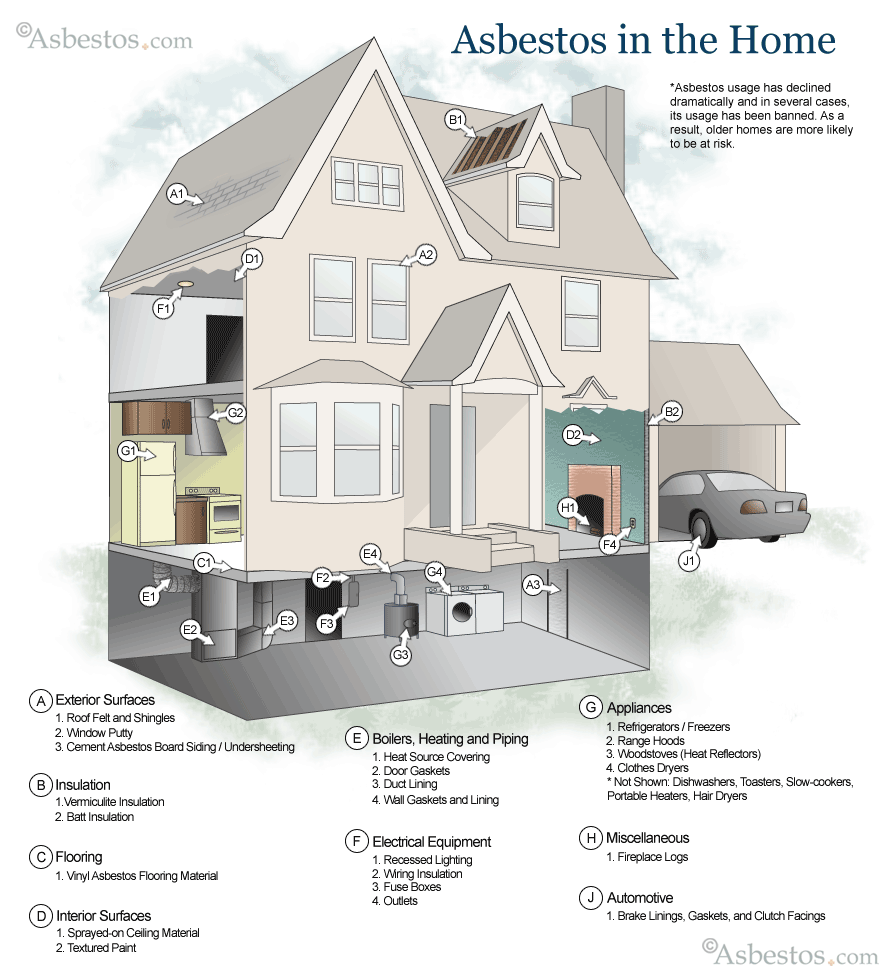What is Asbestos?
Asbestos is a mineral fiber. It can be positively identified only with a special type of microscope. There are several types of asbestos fibers.
Where is Asbestos found and when can it be a problem?
In the past, asbestos was added to a variety of products to strengthen them and to provide heat insulation and fire resistance. Most, but not all, home building materials made today do not contain asbestos. However, up until 1978, the production of many types of building and insulation materials used in homes contained asbestos. Products produced prior to 1978 and even some imported building materials after 1978 are sometimes found in homes built after 1978. Common products that might have contained asbestos in the past include:
- Steam pipes, boilers, and furnace ducts insulated with an asbestos blanket or asbestos paper tape. These materials may release asbestos fibers if damaged, repaired, or removed improperly.
- Resilient floor tiles (vinyl asbestos, asphalt, and rubber), the backing on vinyl sheet flooring, and adhesives used for installing floor tile. Sanding tiles, scraping or sanding the backing of sheet flooring during removal can release fibers.
- Cement sheet, millboard, and paper used as insulation around furnaces and wood burning stoves. Repairing or removing appliances, cutting, tearing, sanding, drilling, or sawing insulation may release asbestos fibers.
- Door gaskets in furnaces, wood stoves, and coal stoves. Worn seals can release asbestos fibers during use.
- Soundproofing or decorative material sprayed on walls and ceilings. Loose, crumbly, or water-damaged material, and sanding, drilling, or scraping the material may release fibers.
- Patching and joint compounds for walls and ceilings, and textured paints. Sanding, scraping, or drilling these surfaces may release asbestos.
- Asbestos cement roofing, shingles, and siding. Some roofing and siding shingles are made of asbestos cement. Houses built between 1930 and 1950 may have asbestos as insulation. Asbestos may be present in textured paint and in patching compounds used on wall and ceiling joints. Their use was banned in 1977. These products are not likely to release asbestos fibers unless sawed, drilled, or cut.
How to identify materials that contain Asbestos
You cannot tell whether a material contains asbestos simply by looking at it, unless it is labeled. Even though an experienced professional inspector can identify suspect material for containing asbestos it can only be determined by sample analysis. Since a professional knows what to look for, and because there may be an increased health risk if asbestos fibers are released when sampling is done incorrectly, you should always hire a professional.
For more information on asbestos in consumer products
Call or write to the U.S. Consumer Product Safety Commission, Washington, DC 20207. The CPSC Hotline has information on certain appliances and products, such as the brands and models of hair dryers that contain asbestos. Call CPSC at 1-800-638-CPSC.
Contact us today and tell us about your needs. We’re happy to work together and tailor a plan specifically for you!

Alpha Environmental respects your privacy and will not divulge your contact information to any third party organization or entity without your express permission. In addition, this web site gathers no unauthorized information from your computer during your visit with us.
The Alpha Promise
At Alpha, we promise to provide exceptional engineering and environmental consulting services in order to develop a long-term client relationship built upon Integrity, Confidentiality, Accuracy, Reliability and Accessibility. All engineering is offered / performed by Alpha Engineering Services, PA
Corporate Office
Office Hours
Monday – Friday: 8:00am to 5:00pm
Saturday / Sunday: Closed

